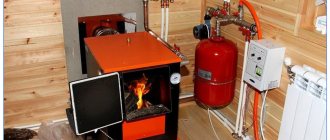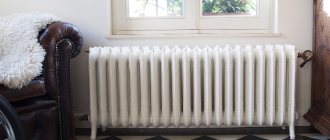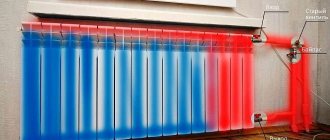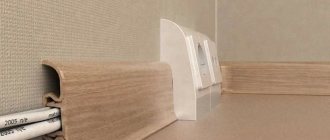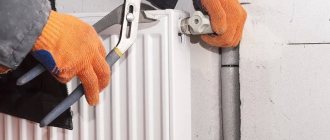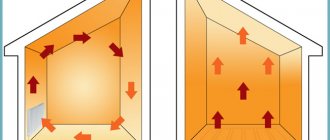There are frequent situations when the problem of a heating battery not heating arises. Sometimes you have to rack your brain in search of the reasons why the situation is happening and how to fix it. We have collected for you 7 possible reasons why radiators may not heat up and offer to study each in detail.
Important! This article is especially relevant when starting heating systems. Many, like you at the moment, may be experiencing difficulties with batteries. Your repost of our material may help someone quickly solve their problem. Don't forget to click on the social buttons. networks at the very bottom of the article!
Why batteries in a private house do not heat well, what to do
But, unfortunately, the coolant enters the radiator in a non-optimal manner, i.e.
not into the upper, but into the lower radiator manifold. We have already written in more detail about what to do if the batteries do not heat up. What can we say about secondary housing built 30-40 years ago. Where to go and how to behave correctly in order to quickly “warm up” the batteries? Why do batteries heat poorly in a private home? The reason may be an incorrectly selected boiler power. That is, it does not have enough resources to heat the required amount of liquid. If no problems are found with the boiler and it is working correctly, then the reason why the batteries are cold should be looked for in the circuit itself. If the batteries are cold, then you need to check all the above factors. You will have to drain water from cold radiators in a private house. What to do is known, you need to unscrew one end (bottom) of the battery and substitute a larger vessel.
We will separately consider the disruption of coolant circulation due to improper pipe routing and piping of heat exchangers, as a result of which the batteries are cold. There may be several reasons why the batteries, instead of delighting with their “hot temperament,” are a little lukewarm. This is easy to do: place your hand on the riser, and then on each of the batteries. Insufficient heating of the battery may be due to the fact that an air lock has formed in it, as a result of which hot water cannot fully circulate in it.
In principle, from time to time the air from the system needs to be bleed, without waiting for the problem to manifest itself by a drop in temperature in the batteries. This is a troublesome task, fraught with the risk that water from the radiator will pour onto the floor. In any case, it is better to invite a plumber to do this work. And at the same time let him install at least the simplest Mayevsky cranes on the batteries. The battery is connected to the riser in two places - at the top and bottom. Hot water flows into the battery from the top, washes all its parts from the inside, and flows out from below.
You can help yourself by installing a simple element called a duct extension into the “wrong” battery. Nothing complicated: a regular long tube with one narrowed end, which is inserted into the battery through the top connection. As a result of this, in no part of the battery will the batteries be cold or too hot (heating devices that are located closer to the boiler usually overheat). 16:06 10/20/2011 Even in new buildings, heating problems are not uncommon.
They are no worse or better than cast iron ones, they are simply designed for other hydraulic circuits of heating systems. And this can only be ensured with the relative cleanliness of the pipes and radiators, as well as the non-interference of residents and illiterate housing department (UK) workers in the design design of the entire riser.
After all, roughly speaking, only 1/18th of the coolant is intended for this one radiator. It can be seen that the coolant rising along the riser (for example, the 2nd floor) changes its direction to the left at the turn, and part of it “jumps” into the radiator by inertia.
We can only consider the question in general. There are different reasons and they are not always obvious. In your home, you can say with almost 100% probability that the heating circuit is autonomous. Although in this case the heat exchangers will heat up at least a little. And if the water in them is completely cold, it means that the boiler is broken or cannot turn on.
In addition, there is an automation and security system. In any case, the sensor will send a command to the control unit and it will not allow the boiler to turn on. The specificity of a private house is that all characteristics can be controlled independently. Then make sure there is no dirt in the pipes and heat exchangers. How to do it?
It is necessary to rinse the circuit to clean water. Sometimes thick liquid flows out of radiators along with water. This is dirt collected in copious amounts. In general, in an autonomous circuit the coolant pressure does not exceed two atmospheres. It was believed that it was simpler and cheaper, but in reality this is not the case. In addition, in this scheme it is very difficult to regulate the temperature of the heat exchangers as they move away from the boiler room.
It turns out that water enters the heat exchanger, cools there and is again drawn into the general flow. Accordingly, after each radiator the overall flow becomes colder.
As a result, the water may reach the extreme heat exchanger almost cold. If their temperature is approximately the same cool, your heating radiators have nothing to do with it. They simply cannot provide more heat, since the coolant they receive is not heated enough. In a private house, the boiler may be to blame for this, or you yourself may be to blame, because you purchased a boiler whose power is not enough to heat the entire building. It may very well be that the problem is its incorrect connection to the system.
Human factor
A person can also become the direct cause of a non-heating radiator. And usually they are as follows:
- A riser that they simply forgot to turn on because “it was late and the plumbers were tired.”
- Closed valve of the automatic air vent system.
- Incorrect connection during installation.
- Child-closed three-way valve.
They can be solved by calling the appropriate support service, correctly connecting the battery (or bypass, see below), and carefully checking the taps.
Let's consider the operation of a U-shaped riser in its downward part.
The duct extension is also very inexpensive, but it perfectly solves the problem of poor water circulation in the event of an incorrect connection of the radiator. If you have independent heating, then you are certainly in a better position. If only because by inserting a small device into the system - a circulation pump - you activate the movement of hot water through the pipes and radiators.
Print out the claim in two copies. Transfer one to the DEZ (housing department or other management company). In this case, the reasonable period will be counted from the date the utility company received your letter. In Moscow this is a district government, in other regions - district administrations, village councils, etc.
Balancing valve
Privately owned houses have the greatest variety of heating systems. Cases of two or three branch structures are not uncommon. In this case, as in the above cases, the tendency of the liquid to take the shortest route naturally remains. The longest arm may have no circulation at all or very weakly expressed. The heat transfer of such a link will be the same - small, absent. The battery will not heat or heat poorly.
To eliminate the situation, it will be necessary to install a balancing valve in order to equalize the pressure of different branches and uniform heating.
Disruption of coolant circulation
This body is authorized to monitor, among other things, the quality of public services, the work of management organizations and issue mandatory orders to violators. Residential multi-storey buildings in the 60s - 90s of the last century, and often even now, are built using a single-pipe vertical heating system.
To simplify, let’s consider such a system in a three-story building. But with such U-shaped risers, many five and nine-story buildings have been built throughout the country. And the operation of such a system was designed exclusively for the use of cast iron radiators. In such houses, looking ahead, it is absolutely forbidden to change the type of heating device. But with the advent of aluminum, and especially bimetallic radiators, a very bad (and even critical) situation arose.
What are the consequences of inefficient operation of heating devices?
The problem of uneven heat distribution in a heating radiator cannot be solved by itself. If you do not pay attention to it, it is fraught with the following consequences:
- The efficiency of heating equipment decreases;
- The apartment becomes cold;
- The risk of a pipe burst increases;
- Economic losses. If in an apartment building the heat meter is common to the building, then the cost of services will be divided among all heat consumers, although the heat output will be low.
- There is a possibility of freezing the heating system. This possibility is unlikely, but such cases occur periodically.
If the air temperature in the room does not meet established standards, then residents will be forced to pay utility bills not for the supplied heat, but for the cold air.
In addition, people connect electric heating devices, which entails increased energy costs. Optimal room temperatures:
- living room and bedroom - from + 18 to + 22°C;
- toilet - + 18°C;
- bathroom - from + 20 to + 25°C;
- corner room - from + 20 to + 24°C.
According to GOST, at night (from 00:00 to 05:00) the temperature can drop by 3 degrees, which is not a deviation.
If the reason for the cold bottom of the radiators is a system failure due to the fault of the heat supplier, you need to write a statement to the management company with a clear description of the problem. The housing office is obliged to send a technician who will measure the temperature of the coolant, air and radiators.
As a result, the heating tariff may be recalculated.
If equipment failure is detected in the apartment, prepare for the following consequences:
- repairs are carried out at the expense of the owner of the house;
- If the equipment is outdated, then replacement is carried out by the owner of the apartment.
If the neighbors are proven guilty, they are obliged to fix the problem.
Why do batteries heat poorly? Part 1.
As mentioned above, in a private home there may be many reasons why the batteries do not heat well
. Here are some of them:
1. Batteries are full.
This is unlikely if you have
autonomous water heating.
Dirt in heating and rust in heating
you never will, even if your heating system is fifty years old.
Why? Because if you have an autonomous heating system at home
, then
dirt
cannot enter the heating system from outside.
Regarding rust in heating
, then it is not available in autonomous water heating either. Why? Because rust does not appear without oxygen. That is, if you do not drain the water in the system for the summer, then oxygen does not enter your heating system. This means there will be no rust in the heating even after fifty years.
2. Hydraulics of the heating system.
A very common reason why
batteries in a private home do not heat well
.
In this case, one heating branch or ring through which water circulates in the heating system
will work well, the other heating branch will work poorly.
This usually happens if your heating system is new,
or if you have added several radiators to an existing heating system.
In this case, some batteries heat up, the last batteries are cold
, due to the fact that the heating hydraulics were incorrectly calculated, that is, the diameter and length of the heating pipe.
Your system may have control valves
in order to
adjust the hydraulics of your heating system
. In this case, it is necessary to adjust the hydraulics of your heating system using control valves.
3.
Single-pipe water heating system.
A single-pipe water heating system is a fairly common system in older homes.
Typically, this system has thick pipes, a heating system of natural coolant circulation
, that is, a non-volatile
heating system without pump circulation.
It works like this: the batteries that are closer to the boiler heat well,
the distant batteries heat worse
, that is,
the last batteries are cold,
this is the normal operation
of a single-pipe water heating system.
Nothing can be changed here, except perhaps converting a single-pipe water heating system to a two-pipe one, that is,
installing a two-pipe heating system
.
Automation for gas heating boilers.
Modern water heating systems are automated and energy-dependent. This includes boilers with built-in automation, pumps, sensors, etc. In this case, you will need the help of a specialist, since the system is quite complex and most likely under warranty. Contact the gas boiler startup service. As a rule, such a service department makes the first start-up of a gas boiler, deals with warranty service and repairs of the gas boiler.
The service specialist will check whether the automation in your water heating system is connected correctly and whether everything is working properly, and also, if necessary, will make the necessary repairs.
Flow extender
A typical problem for a two-pipe system. Is it possible to make any number of sections? It is possible, but the very last sections of the battery will not warm up. Cause? Water, like a person, looks for “where it’s easier” and follows the shortest path. In order to “teach order” to the lazy one - water, a flow extender is required. Factory-made, or made independently from a piece of pipe. By directing the fluid to the middle of the structure, it will force the flow to circulate correctly, reaching the farthest ends of the heat exchanger.
Interesting fact: the same problem can be solved by connecting the heating device “diagonally”. But this is rarely used, due to the lack of aesthetics of this solution on ready-made systems.
Some tips for craftsmen
Many problems can be avoided if you do a few things first. Autonomous heating of a private house has an expansion tank for the system. If you weld a faucet to the lower pipe and gradually feed water into it, the air lock will escape through the tank. The system is filled with water through the same tap, then plugs will not appear. The only thing required is an assistant to monitor the water level in the tank.
To remove air from cast iron batteries, install a Mayevsky tap on the top plug. This is not at all difficult, you just need to unscrew the plug in the summer, drill a hole of the required diameter in the center and cut the thread with the required pitch. The plugs are made of cast iron, the material is easy to process.
If the battery does not give off heat well for no apparent reason, it may be touching the wall. The larger the contact area, the more heat is wasted. Eliminate contact by moving the radiator slightly away. Do not cover the batteries with decorative grilles, which reduce heat transfer. It is better to attach a reflective screen made of foil material behind the radiator - heat transfer will increase.
The heating system seems simple only at first glance, but in fact it has its own secrets and tricks. Everything seems complicated and confusing for a beginner. But once you understand the issue, the main points become clearer.
Return is hot and supply is cold
Why is the return hot and the supply cold? This is a rare occurrence. It can be observed when the pump is installed in reverse and without a check valve. This is also possible due to the operation of the heated floor pump. When the floor is first started and heats the structure, it operates at full capacity and can, under certain circumstances, change the circulation in the radiator circuit. Once the floor warms up, it may go away on its own. If the pipes are hidden, then you need to check whether the pipes (supply and return) are mixed up. You can do it in different ways: with water or just blow.
Connection errors
Another reason why batteries may remain cold is incorrect connection of heating system elements. The biggest mistake is connecting radiators to pipes, in which water is supplied from below. In this case, the sections are heated unevenly, and part of it remains cold. This is most often typical for side connections. What should I do to ensure that the surface of the radiators heats up evenly and the apartment becomes warm? To do this, you need to correctly connect them to the system.
p, blockquote 11,0,0,0,0 –>
Too many sections can also contribute to uneven heating, since coolant circulation is difficult. A special extension cord connected to the pipe that supplies hot water to the battery will help improve it.
p, blockquote 12,0,0,0,0 –>
Advice! For uniform heating of radiators, the best option is a diagonal connection, which ensures maximum efficiency of the heating system.
How to solve a problem?
The most rational way is to call a plumber. And the following tips will help you draw up a plan for resuscitation of your cold batteries with a specialist:
1. To get rid of traffic jams, you need to install a Mayevsky tap on the battery.
2. Rinse the radiator (it is more rational to do this before the start of the heating season).
3. Replace the battery. This option should be used only in a situation where all “resuscitation measures” have already been used. You should only buy a radiator from a reliable company.
The riser is blocked
The reasons when the riser in a multi-storey building is blocked affect all residents who live in the “disaster area”. In fact, unauthorized blocking of the riser can be done by one of the residents out of ignorance. In any case, with such an overlap, there is a need for the intervention of regular plumbers to clarify and fix the problem. Of course, this causes the batteries to become cold.
More frequent causes of a blocked riser occur after any repairs have been carried out that required such a blocking. Each riser of a multi-apartment multi-storey building is equipped with shut-off valves at the top and bottom. Carrying out repairs in which both the upper and lower taps are closed requires special permission.
At the end of the repair, the specialists could simply forget to turn the riser back on to normal mode. If, in the user’s opinion, the riser is blocked, then you should contact the relevant organization and find out the details. You should not attempt to restore the riser operation without permission.
Balancing the heating system
Uneven heating across sections of the system should be eliminated by balancing the input in each battery. Typically, the location of the heating radiators further away from the boiler requires a greater flow of heated water when circulating. Such balancing should be done using existing taps and possible adjustment of bypasses. This is especially true if the last radiator in the house is cold.
To “finely” balance the heat transfer of each individual radiator, it is useful to remember the possibility of using a “flow extender”. This does not exclude the possibility of adjustment using three-way valves.
When installing a heated towel rail, it is necessary to take into account that it has less resistance to the circulating flow. Consequently, the heat consumption will be greater than in the batteries next to it.
Shut-off valve is faulty
It regulates the movement of the working environment, and also completely or partially blocks it.
This includes the following devices:
- thermal heads,
- valves,
- Ball Valves.
With their help, you can adjust the temperature in the room and reduce costs if a heat meter is provided.
There is an arrow indicator on the taps. It indicates the direction of fluid movement. For the highway to work properly, mistakes must not be made.
In addition, for some types of valves there are requirements regarding their location in space. If the devices are installed incorrectly, the circulation of the coolant is disrupted. As a result, the top of the battery remains hot and the bottom becomes cold.
